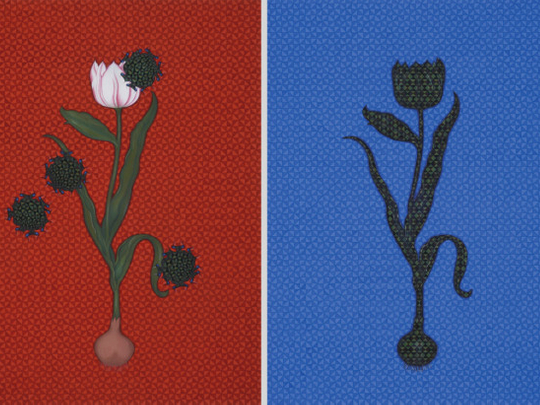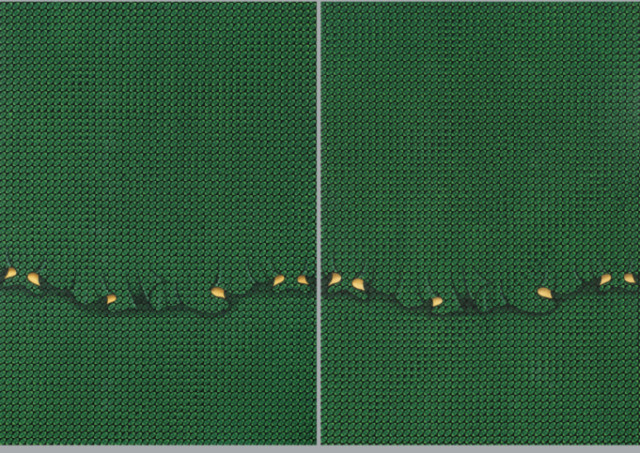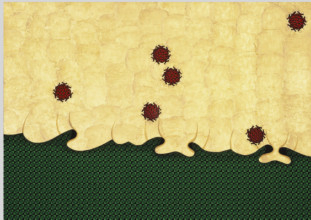
Well-known Pakistani artist Aisha Khalid was trained in Mogul miniaturist traditions. But over the years her work has become more abstract and larger in scale. Her first solo show in the region, titled “The Divine is in the Detail”, is inspired by her deep interest in Sufism and spirituality. But the large abstract paintings and embroidered textile installations are also layered with socio-political subtexts.
The artist uses the traditional miniaturist’s medium of gouache on Wasli paper to create her multi-panelled paintings. She combines repetitive geometric patterns, colours that have significance in Islamic and Sufi philosophy, and symbolic motifs to create these abstract landscapes of our inner and outer universe. “My work is about searching for the divine through meditation. I like working on a large scale because I want to completely immerse myself in the work. The process of creating the repetitive patterns and intricate embroidery is long and laborious, but I see it as a form of meditation that is central to my work. The title of my show is a play on the phrase ‘the devil is in the detail’ because for me, the divine is indeed in the detail,” she says.
The titles of her artworks are derived from poems by Sufi poets. “I am greatly inspired by the biographies and works of Sufi philosophers such as Jalaluddin Rumi, Nizamuddin Auliya and Baba Farid. But my paintings are not about illustrating their words. I choose the title after a work is finished because I feel it resonates with the emotions and ideas I want to express,” Khalid says.
She has used Rumi’s words “Wound is a place where the light enters you” for two individual pieces. In both pieces, a golden fabric with folds appears to be spread over a red or green background of repetitive geometrical patterns. And this abstract mystical landscape is dotted with jagged, circular, organic shapes.
“My work can be interpreted in multiple ways, and includes both the poetic and political registers of meaning. So I often use words from Rumi’s poetry because they are open-ended, and have significance both in the material and the spiritual domain. The folds and spheres in these works have evolved from my earlier figurative work. Gradually the figure disappeared behind the curtain and veil, which was further simplified into just the folds at the hem. The circular forms on this mechanical, geometric background are like pores that signify human presence. But when painted with camouflage colours they symbolise bullet holes. I am focused on Sufism and the relationship between human beings and God, but I just cannot ignore the pain and violence that is all around us. So these works depict the reality of the physical and material world and the spiritual layer beyond. They talk about the violence on the surface and something precious that is being destroyed within, and the pain our soul must endure on its journey in search of the divine,” Khalid says.
Another set of three diptychs called “West looks East” is a poetic representation of two conflicting personalities depicted in blue and red. A tulip, signifying the West appears on the panels, sometimes as a bright organic presence, sometimes as a hidden shadowy element and sometimes divided between the panels. The bullet wounds are present here. Once again the work has spiritual as well as socio-political connotations.
“This work is about our inner and outer selves, as well as about relationships between two people, societies and cultures. It reflects my country’s colonial history and the continuing effects of Western colonial rule on Pakistani society. It talks about how the West sees us and wants us to see ourselves. The separation between the two panels indicates the divide between the two sides. But the bullet marks on both sides indicate that their actions in our part of the world do have repercussions in their part of the world,” she says.
The installation titled “Yourself of Yourself” is also about our relationship with ourselves and others. It features two silk-lined velvet jackets modelled on the artist’s body. While one is black on the outside and red inside, the other is just the opposite. And at various places, the beautiful traditional embroidery on one is mirrored by dressmaker pins inserted right through the fabric in the other.
“This work was inspired by Rumi’s words,‘Be like melting snow; wash yourself of yourself.’ I used black velvet for its association with spirituality, especially with the covering of the Ka’aba. And the red colour has multiple meanings. The pins, associated with pain and blood, emerge on the red side of both jackets after piercing through the layers of fabric. I have deliberately placed the two jackets in contact with each other. This work is about recognising yourself and observing your public and private personas. It is about the beauty and the pain that are part of our being, and that we show to the world or conceal from it. It could also be about relationships between two separate individuals,” Khalid says.
Jyoti Kalsi is an arts enthusiast based in Dubai.
The show will run at Gallery Isabelle van den Eynde until October 10.




